2-(Diphenylphosphino)benzoic acid
Synonym(s):(2-Carboxyphenyl)diphenylphosphine
- CAS NO.:17261-28-8
- Empirical Formula: C19H15O2P
- Molecular Weight: 306.3
- MDL number: MFCD00674024
- EINECS: 241-293-7
- SAFETY DATA SHEET (SDS)
- Update Date: 2023-04-23 13:52:06
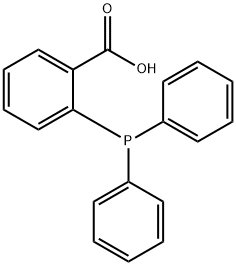
What is 2-(Diphenylphosphino)benzoic acid?
Chemical properties
light yellow powder
The Uses of 2-(Diphenylphosphino)benzoic acid
2-(Diphenylphosphino)benzoic Acid is used in small molecule control of protein function through staudinger reduction.
The Uses of 2-(Diphenylphosphino)benzoic acid
The ligand (R ,R )‐1,2‐Bis(aminocarbonylphenyl‐2′‐diphenylphosphino)cyclohexane[138517-61-0] can be prepared by the coupling of (1R ,2R )‐(-)‐1,2‐diaminocyclohexane [20439-47-8] with 2‐(diphenylphosphino)benzoic acid [17261-28-8], using reagents such as DCC.
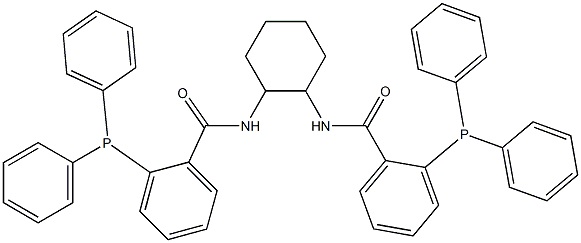
An alternative procedure has been developed where by (1R ,2R )‐(+)‐1,2‐diaminocyclohexane L‐tartrate salt [39961-95-0] is coupled to a mixed anhydride of 2‐(diphenylphosphino)benzoic acid and diphenylchlorophosphate.The procedure is reproduced below 2‐(Diphenylphosphino)benzoic acid (20 g, 65.3 mmol, 2 equiv) is suspended in dichloromethane (150 mL) and cooled in an ice‐water bath to 0°C (internal temperature). Triethylamine (10.1 mL, 71.8 mmol, 2.2 equiv) is added dropwise and a clear solution is obtained. This process is exothermic and a rise in temperature to 5°C is observed. The solution is re‐cooled to 0°C and diphenylchlorophosphate (13.4 mL, 64.7 mmol, 1.98 equiv) is added slowly, maintaining the internal temperature between 0–5°C. The yellow solution is stirred for 1 h at 0°C. (1R, 2R )‐(+)‐1,2‐Diaminocyclohexane‐L‐tartrate salt (8.63 g, 32.65 mmol, 1 equiv) is suspended in water (50 mL, 5.8 vol) and potassium carbonate (15 g, 107.8 mmol, 3.3 equiv) is added. This process is exothermic and a clear solution is obtained after approximately 10 min. After 30 min, the clear aqueous solution of diamine is added to the mixed anhydride solution at 0°C, and the resulting yellow two‐phase mixture is stirred for 2 h at 0°C, then allowed to warm to room temperature. After 14 h, the mixture is poured into a separating funnel and 200 mL of dichloromethane and 100 mL of water are added. The organic phase is separated, washed with 2 N HCl (100 mL) and saturated aqueous NaHCO3 solution (100 mL), then dried over magnesium sulfate. The dried organic phase is filtered through a silica pad and the pad is washed with dichloromethane (50 mL). The combined filtrates are evaporated to dryness under reduced pressure, producing a yellow foam (22.3 g, 99% crude). The foam is crystallized from boiling acetonitrile (390 mL, 17.5 vol) to afford a white crystalline solid. The solid is dried under vacuum to provide the phosphine ligand (15 g, 67%).
Properties of 2-(Diphenylphosphino)benzoic acid
| Melting point: | 174-181 °C (lit.) |
| Boiling point: | 159 °C |
| storage temp. | Inert atmosphere,Room Temperature |
| solubility | Chloroform (Slightly), DMSO (Slightly), Methanol (Slightly) |
| form | Powder |
| pka | 3.72±0.36(Predicted) |
| color | Light yellow |
| Stability: | Hygroscopic |
| CAS DataBase Reference | 17261-28-8(CAS DataBase Reference) |
| EPA Substance Registry System | Benzoic acid, 2-(diphenylphosphino)- (17261-28-8) |
Safety information for 2-(Diphenylphosphino)benzoic acid
| Signal word | Warning |
| Pictogram(s) |
 Exclamation Mark Irritant GHS07 |
| GHS Hazard Statements |
H315:Skin corrosion/irritation H319:Serious eye damage/eye irritation H332:Acute toxicity,inhalation H335:Specific target organ toxicity, single exposure;Respiratory tract irritation |
| Precautionary Statement Codes |
P261:Avoid breathing dust/fume/gas/mist/vapours/spray. P264:Wash hands thoroughly after handling. P264:Wash skin thouroughly after handling. P271:Use only outdoors or in a well-ventilated area. P302+P352:IF ON SKIN: wash with plenty of soap and water. P305+P351+P338:IF IN EYES: Rinse cautiously with water for several minutes. Remove contact lenses, if present and easy to do. Continuerinsing. |
Computed Descriptors for 2-(Diphenylphosphino)benzoic acid
| InChIKey | UYRPRYSDOVYCOU-UHFFFAOYSA-N |
New Products
4-AMINO-TETRAHYDRO-PYRAN-4-CARBOXYLIC ACID HCL 4-(Dimethylamino)tetrahydro-2H-pyran-4-carbonitrile 4-Aminotetrahydropyran-4-carbonitrile Hydrochloride (R)-3-Aminobutanenitrile Hydrochloride 3-((Dimethylamino)methyl)-5-methylhexan-2-one oxalate 1,4-Dioxa-8-azaspiro[4.5]decane 5-Bromo-2-nitropyridine Nimesulide BP Aceclofenac IP/BP/EP Diclofenac Sodium IP/BP/EP/USP Mefenamic Acid IP/BP/EP/USP Ornidazole IP Diclofenac Potassium THOMAIND PAPER PH 2.0 TO 4.5 1 BOX BUFFER CAPSULE PH 9.2 - 10 CAP SODIUM CHLORIDE 0.1N CVS ALLOXAN MONOHYDRATE 98% PLATINUM 0.5% ON 3 MM ALUMINA PELLETS (TYPE 73) LITHIUM AAS SOLUTION 2-Bromo-1-(bromomethyl)-3-chloro-5-nitrobenzene 2-Bromo-3-nitroaniline N-(3-Hydroxypropyl)-N-methylacetamide 3-Bromo-6-chloropyridazine 4-ethyl-3-nitrobenzoic acidRelated products of tetrahydrofuran
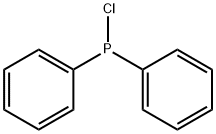
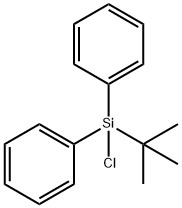


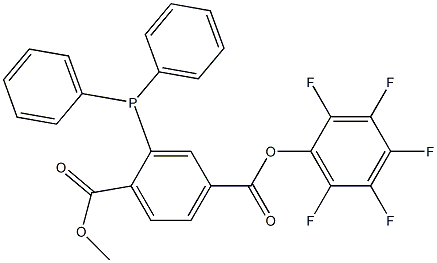
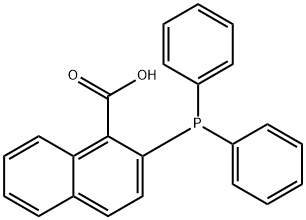


You may like
-
 2-(Diphenylphosphino)benzoic Acid CAS 17261-28-8View Details
2-(Diphenylphosphino)benzoic Acid CAS 17261-28-8View Details
17261-28-8 -
 2-DIPHENYLPHOSPHINO BENZOIC ACID CAS 17261-28-8View Details
2-DIPHENYLPHOSPHINO BENZOIC ACID CAS 17261-28-8View Details
17261-28-8 -
 2-(Diphenylphosphino)benzoic acid CAS 17261-28-8View Details
2-(Diphenylphosphino)benzoic acid CAS 17261-28-8View Details
17261-28-8 -
 1823368-42-8 98%View Details
1823368-42-8 98%View Details
1823368-42-8 -
 2-(3-(tert-butyl)phenoxy)-2-methylpropanoic acid 1307449-08-6 98%View Details
2-(3-(tert-butyl)phenoxy)-2-methylpropanoic acid 1307449-08-6 98%View Details
1307449-08-6 -
 Ethyl 3-(furan-2-yl)-3-hydroxypropanoate 25408-95-1 98%View Details
Ethyl 3-(furan-2-yl)-3-hydroxypropanoate 25408-95-1 98%View Details
25408-95-1 -
 2-Chloro-5-fluoro-1-methoxy-3-methylbenzene 98%View Details
2-Chloro-5-fluoro-1-methoxy-3-methylbenzene 98%View Details
1805639-70-6 -
 Lithium ClavulanateView Details
Lithium ClavulanateView Details
61177-44-4